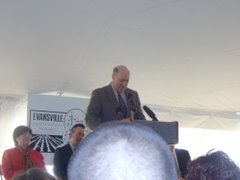Here at City Hall, we have followed two items in the recent news with particular interest. President Obama signed the American Recovery and Reinvestment Act of 2009; this is also known as the economic stimulus package. And Governor Doyle presented his recommendation for the state’s 2009-2011 budget.
Evansville’s involvement with the stimulus package began in early December when the Wisconsin Office of Energy Independence asked if we had any clean, green job-creating projects which would be ready to go within 90 to 180 days. Our one project that may have met those criteria was the planned upgrade of the wastewater treatment plant (WWTP).
Our current wastewater facility was built in 1982, designed to last 20 years with a capacity of 600,000 gallons per day. Subsequently, in the early 1990’s, the Department of Natural Resources (DNR) adopted new discharge limits, including a groundwater limit of 10 milligrams per liter.
Currently our wastewater facility does not consistently meet DNR limits for nitrates or chlorides. Even though we are several years beyond the designed lifespan, the plant runs at about 75 to 85 percent of its designed capacity. The requirement to change our wastewater treatment to reduce nitrates is the primary factor behind significant upgrades for our WWTP.
The planned upgrades to the WWTP will involve the installation of a mechanical plant at the cost of about $4.25 million. The improvements will include added capacity to accommodate future industrial and residential growth in the city. It is also being designed to be extremely energy efficient and will be the first WWTP in the state to meet Leadership in Energy and Environmental Design (LEED) standards. Even though energy efficiency may add to the upfront costs; lower operating costs make this the most cost effective approach over the life of the WWTP.
There are several key points to this project which may be applicable for any potential stimulus funding. First and foremost, it is “shovel-ready,” meaning it is ready to begin construction within a few months. The engineering has already advanced enough and we have even pre-bid some of the mechanical equipment that construction is scheduled to begin this spring. If one of the features of the stimulus money is that it be put to immediate use, the WWTP certainly meets that expectation. And it will support jobs during its 15 to 18 months construction. Depending on the phase of construction and nature of the work at hand, at its peak there could be 25 to 30 construction workers on site.
For the most part, the federal stimulus money is being funneled into existing programs. For wastewater collection and treatment, this means the state’s Clean Water Fund. In discussion with state officials, we understand that the Clean Water program has around $1 billion in potential projects statewide for some $400 million in funding. In order to manage the list, and to focus on shovel-ready projects, projects had to be on the DNR’s list last November to be considered for the stimulus funds. It is coincidence that we submitted our facility plan in November; but we lucked out and are on the consideration list.
Another feature that benefits our project is the emphasis on energy efficiency: 98% efficient motors and pumps, LEED design, and probably a small wind turbine for electrical generation. Sanitary sewer infrastructure may be the most obvious description of the project, but we may have access to some other stimulus money because of these energy and conservation aspects.
In early January, we were asked through our city engineers to provide a list of any shovel-ready projects the city may have. This was in preparation for the Governor’s trip to Washington and his desire to have a list of potential Wisconsin projects. The list was to serve two general purposes. One, the list would demonstrate the need for federal money (so many thousands of projects totaling so many billions of dollars). And, two, the list could be categorized to roads, to sewers, to buildings, and such, to estimate how and where the anticipated stimulus dollars might be distributed.
It was basically a phone call around 9:00 in the morning saying to submit any projects by noon; everything with the stimulus package has had very short deadlines. We supplied a list of 9 shovel-ready projects, totaling almost $8 million and potentially providing 75 construction jobs. Again the WWTP was the city’s top priority. Our list also included upgrades to our electrical system, park projects (interestingly, the stone creek walls in the park were originally built to provide employment during the Depression), several small street and utility improvements, and the privately-planned community/senior center. Two of our submissions were struck from the list, presumably because they were too small to be considered (around $50,000-$75,000).
Then a couple weeks ago, discussions between the Department of Transportation (WisDOT) and the League of Wisconsin Municipalities led to WisDOT’s solicitation of street re-surfacing projects. They were looking for relatively small projects throughout the state, that could be accomplished with minimal engineering or preparatory work, could be done within existing rights-of-way, and had to be classified as a collector road or better.
Evansville submitted the re-surfacing of County Road C (West Main Street and North Fourth Street) between First Street and the city limits. The road is a collector and has a state pavement rating of “fair,” with an aging but structurally sound condition, needing a non-structural surface overlay. This project would include selective replacement of curb and gutter and the replacement of five sanitary sewer manholes. Our project has made the first cut, which basically means it met the eligibility criteria.
And, although they are not specifically on the list of the city’s infrastructure projects, if there were some opportunity that the stimulus package could help advance the soybean crushing facility or an occupant for the vacant Stoughton Trailer building; the city would obviously support a project that meets local economic development needs.
Whether through direct contact with state officials or through our city engineer or the League of Wisconsin Municipalities, we have followed the development of the federal stimulus package and have submitted several infrastructure projects for funding. Everything with the stimulus package has had very short deadlines; fortunately we have several projects that are advanced enough or straight-forward enough to submit under such an expectation of immediacy. At this point none have been awarded money, but we do stand a strong chance at seeing some of the stimulus dollars going to infrastructure in Evansville.
The other recent news that was followed closely at City Hall was the Governor’s budget proposal. The main items of concern for city operations were shared revenue, general transportation aid, and levy limits.
The Governor proposed keeping 2009 shared revenue at the 2008 levels and then cutting it by 1% in 2010. The 1% reduction is to be apportioned among local governments first on the basis of equalized value, with no municipality’s payment reduced by more than 15%. The remainder of the reduction would be accomplished on a per capita basis. The Legislative Fiscal Bureau needs a couple weeks to analyze this and other portions of the proposed budget before reporting on how the cuts would be distributed among municipalities throughout the state.
From a management standpoint, I am quite pleased to hear that the proposed cuts would not take effect until next year; it will be easier to plan how to address it in the city’s budget.
In 2008 we received $484,196 in shared revenue from the state; at about 17% of our general fund operating budget, this supports a significant portion of city operations. If the reduction is likely between 1% and 15%, Evansville can expect to lose between $4,800 and $72,600 next year. I do not mean to sound alarmist; we will play the hand we are dealt. But we already run a very tight budget, so significant reductions will be felt in eliminated or cut services or in increased user fees and property taxes. It is simply the reality of the current economy that it will be felt at a number of levels.
The Governor proposed leaving the 2009 funding level for general transportation aid untouched, reducing the program by 1% in 2010, and then holding 2011 the same as 2010. Again, the specific details about how this would be distributed are undetermined. At $227,814 in 2009, general transportation aids are also a significant part of the city’s operations.
The Governor proposed extending levy limits for another two years. Under his proposal, in 2009 and 2010, municipalities would be able to increase their property tax levies by the greater of 3% or the percentage increase in equalized value due to new construction. The Governor also recommended that municipalities be allowed to carry forward unused levy capacity.
The city has actually been able to address inflationary costs and new services while reducing the property tax rate the last few years. This has been due to holding a tight budget and due to growth in the tax base. But with the severe slow down in construction the last year, we can expect it to be tighter and more difficult for the city to hold the line on the tax rate going forward, especially if we see reductions in shared revenues.
Personally, my opposition to levy limits is not in some odd desire to raise taxes. I disagree with levy limits because of a fundamental belief that the City Council is in the best position to make tax decisions for local services. But it looks likely that they will be extended, and the city will set its budgets within them.
The economic recession obviously has an impact on jobs. And there is additional financial distress with home mortgages. More than anything, there is certainly a level of anxiety and uncertainty. The slow down will also impact the ways in which city business is conducted. There will be changes. But, all in all, I am quite confident in the ability of the City Council and city staff to continue providing necessary services in a responsible manner.
Thursday, March 05, 2009
Mailbag: View of the City Digital Version: City Administrator Dan Wietecha Writes Re: Stimulus and City Plans
Subscribe to:
Post Comments (Atom)






























Mr.Wietecha,
ReplyDeleteThough you are only doing your job, and I would do the same, it is funny to me how a project that the city was going to pay for pre-stimulus money, is now a job creating green project that will help us come out of the recession. This is not a personal attack, it is me reflecting on jobs that were going to be "created" anyway, but now since stimulus money may be used, these will be counted as new jobs?
Meeting LEED standards is nice, I thought the potential placement of the small wind turbine was politics, since they were looking for "green and clean", you slipped that in to put some icing on the cake. Since you were unable to help me find answers to the questions I emailed you days ago about the high schools wind turbine, maybe you have some inside information that could enlighten me. Mr. Wietecha this is not the Field of Dreams, reliable power will not be had by simply erecting a small turbine. You could also plant avocado's for their health benefits outside the new treatment facility, but it would be more symbolic than realistic.
I do think you are sincere in your efforts, I want "free" stuff for Evansville also, but when its at the expense of novelty, I object.
When it comes to the city of Evansville being a leading renewable energy producer, you can dress up like Superman all day long, but that doesn't mean you can fly.